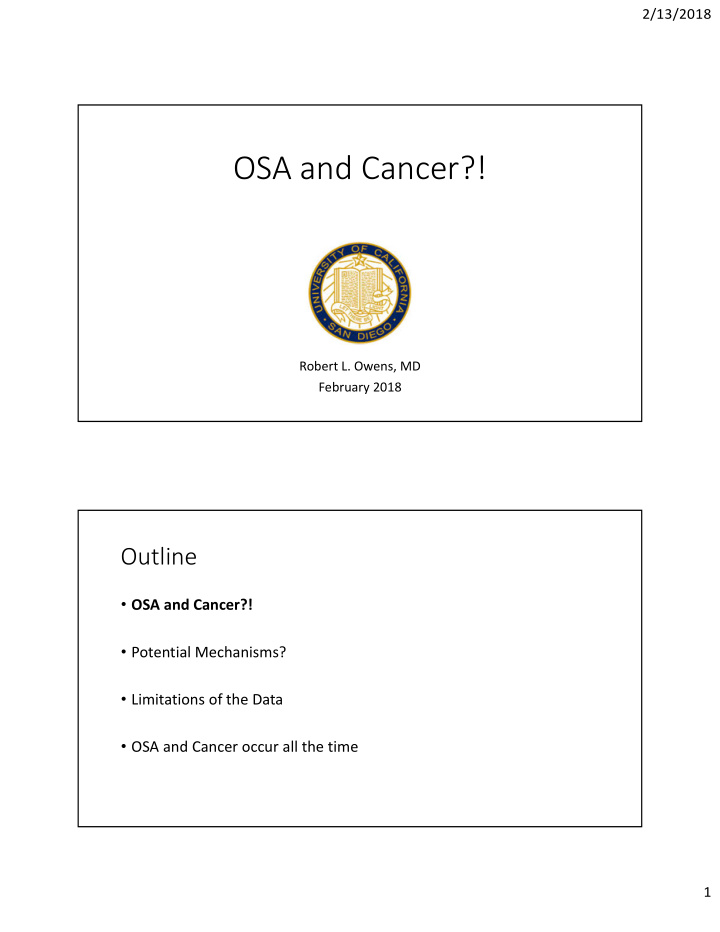



2/13/2018 OSA and Cancer?! Robert L. Owens, MD February 2018 Outline • OSA and Cancer?! • Potential Mechanisms? • Limitations of the Data • OSA and Cancer occur all the time 1
2/13/2018 Thoracic pressure swings (↑LV a�erload) 2
2/13/2018 Consequences Neurocognitive Cardiovascular • Excessive daytime sleepiness • Systemic hypertension • Increased motor vehicle crashes • Cardiac arrhythmias • Increased work‐related accidents • Myocardial ischemia • Poor job performance • Cerebrovascular disease • Decreased quality of life • Pulmonary Hypertension/ cor pulmonale • As compared with those without sleep apnea, patients with an AHI > 10 had an odds ratio of 6.3 (95% confidence interval, 2.4 to 16.2) for having a traffic accident. • This relation remained significant after adjustment for potential confounders, such as alcohol consumption, visual‐refraction disorders, body‐mass index, years of driving, age, history with respect to traffic accidents, use of medications causing drowsiness, and sleep schedule. NEJM 1999 3
2/13/2018 OSA and Hypertension Dog Model of Apnea (Brooks et al, JCI 99:106, 1997) 2005 4
2/13/2018 Atrial Fibrillation and OSA Fein JACC 2013 Pulmonary Hypertension Sajkov AJRCCM 1999, 2002 5
2/13/2018 2013 6
2/13/2018 AJRCCM 2013 7
2/13/2018 What do people die from? An animal model… Almendros ERJ 2012 8
2/13/2018 Reanalysis of WSCS… Cancer‐free survivial Nieto AJRCCM 2012 Outline • OSA and Cancer?! • Potential Mechanisms? • Limitations of the Data • OSA and Cancer occur all the time 9
2/13/2018 AHI vs. Intermittent Hypoxia An animal model… Almendros ERJ 2012 10
2/13/2018 • Respir Physiol Neurobiol. 2013 May 1;186(3):303‐7. doi: 10.1016/j.resp.2013.03.001. Epub 2013 Mar 14. • Intermittent hypoxia increases melanoma metastasis to the lung in a mouse model of sleep apnea. • Almendros I 1 , Montserrat JM, Torres M, Dalmases M, Cabañas ML, Campos‐Rodríguez F, Navajas D, Farré R. A Complicated relationship Tumor ? Cancer Carcinogenesis Growth & Sleep Morbidity Metastasis Apnea & ? Mortality ? Altered Treatment Efficacy 11
2/13/2018 2014 12
2/13/2018 A Complicated relationship DNA Cancer mutations progression Sleep Circadian Reactive Oxygen NRF2 Species (ROS) Deprivation Clock mtDNA Cancer initiating mutations cell death Sleep Apnea Hypoxia HIF1,2 Glycolysis Survival Cytokines Angiogenesis Stress/ Cortisol/ Immuno‐ Cancer Catecholamines deficiency progression Gozal Sleep Medicine Reviews 2016 Not just apnea? • Circadian timing? 13
2/13/2018 Outline • OSA and Cancer?! • Potential Mechanisms? • Limitations of the Data • OSA and Cancer occur all the time Limitations • “Cancer” as a single entity • Diagnosis from DRG codes – does not get into incidence vs. aggressiveness • Studies not specifically designed to look at cancer • Little data on chronic sleep duration, stage, etc. 14
2/13/2018 Limitations • Obesity as a confounder • Risk factor for cancer and OSA • Modifies depth of desaturation • Usually quantified by BMI (which is imperfect) • Is also modified by diet and life style Limitations • Animal studies have looked at tumor growth, aggressiveness • Not de novo tumors • Not the impact of OSA treatment on tumor growth 15
2/13/2018 Outline • OSA and Cancer?! Yes, in multiple cohorts Unclear which cancers • Potential Mechanisms? Intermittent Hypoxia, Sleep Fragmentation • Limitations of the Data Many questions remain What to do in the meantime? • Cancer and OSA occur together all the time • Just by epidemiology/chance • Some cancers may be particularly relevant (e.g. H+N cancers) • Steroids, edema may increase weight • Fatigue a major problem in patients with cancer • More aggressive screening and treatment of OSA in people with cancer could improve patient‐centric outcomes, and if it improves outcomes, so much the better 16
2/13/2018 Questions? rowens@ucsd.edu 17
Recommend
More recommend